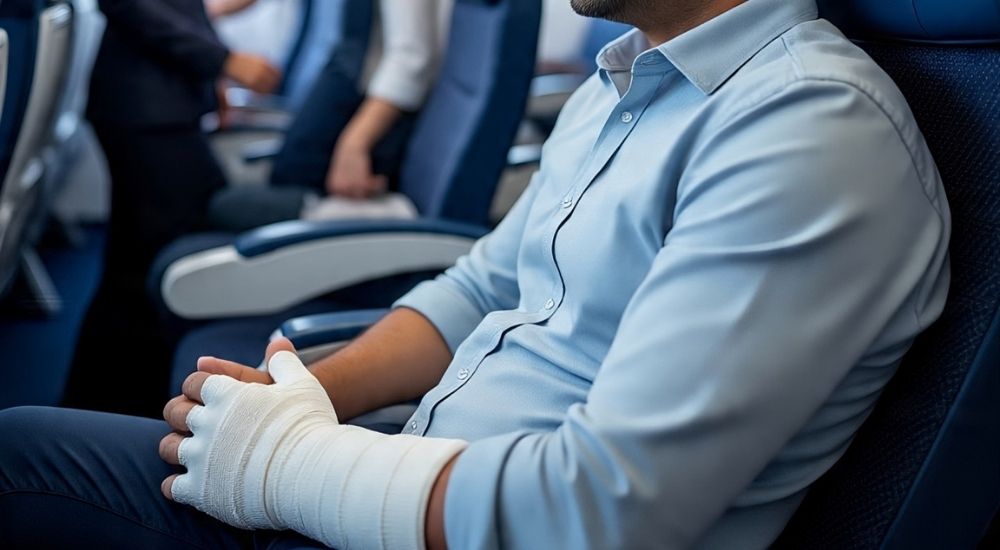Flying with a Fracture: How to Manage Plaster Casts and Pressure Changes Inside Aircrafts

Imagine this: you’re healing from a fracture with a plaster cast snug around your arm or leg, and you’ve got a flight to catch. Do you intuitively feel it’s safe to fly with a cast? Have you ever considered the pressure dynamics that build up inside the cast during flight? What happens to the pressure inside the cast once you’re in the sky? The science is very interesting.
The answer involves a mix of physics, physiology, and practical precautions — and it’s something every patient and caregiver should understand.
Cabin Pressure & Your Body: What Happens in the Air?
Aircraft cabins are pressurized — but not to sea-level pressure. The cabin pressure during cruising altitude (30,000–40,000 feet) is roughly equivalent to being at 6,000–8,000 feet elevation.
At that altitude:
- Air expands (as per Boyle’s Law: gas volume increases when pressure decreases).
- This expansion can affect swelling inside your body, especially in injured or inflamed areas.
- A tight cast that was fine on the ground may constrict circulation during flight.
The Risk with Fractures and Casts in Flight
A freshly applied cast — particularly non-bivalved (un-split) plaster — may become dangerous at altitude due to:
- Increased swelling in the injured limb
- Circulation compromise from pressure inside the cast
- Risk of compartment syndrome, a painful and serious condition caused by elevated pressure in muscle compartments, cutting off blood supply
Common symptoms of a problematic cast mid-flight:
- Tingling or numbness
- Pain unrelieved by medication
- Cold or pale fingers/toes
- Swelling beyond the edge of the cast
Types of Casts & Recommendations for Air Travel
1. Plaster Casts (heavy and rigid)
- Take at least 24–48 hours to fully dry and harden
- Higher risk of swelling-related complications
- Not ideal for flying soon after application
2. Fiberglass Casts (lighter, more breathable)
- Dry faster, more durable
- Still can cause circulation issues if not split
Medical Guidelines Before Flying
Most airlines and medical bodies follow similar safety protocols:
Wait Time After a Fracture:
- Simple fractures: Wait at least 24–48 hours before flying (longer if swelling persists)
- Complex fractures or surgery: Wait up to 7–10 days or as advised by a doctor
Bivalve (Split) the Cast: [1][2]
- Doctors often cut the cast lengthwise (bivalving) to allow room for swelling
- Especially important within 48 hours of injury or casting
- This is essential for long-haul or high-altitude flights
Travel Tips for Cast-Wearers on a Plane [3]
- Get a medical clearance or fit-to-fly certificate
- Especially needed for long flights or visible mobility limitations
- Request aisle or bulkhead seating
- More room to elevate the limb and reduce swelling
- Stay mobile
- Walk a few steps every hour if possible to prevent clots
- Compression stockings
- May be recommended to prevent deep vein thrombosis (DVT), especially in leg injuries
- Hydrate and elevate
- Drink water and keep the injured limb raised on a pillow or bag when seated
- Carry pain medication & doctor’s note
- In case of mid-flight discomfort or if airport security questions your medical device
Final Word from the Experts
“A fracture doesn’t have to ground your plans — but air travel with a cast requires careful preparation. Talk to your doctor, especially if your flight is soon after the injury.”
— Dr. Suresh, Indian Airlines ( Rtd.)
At Nellikka.life, We Recommend:[4]
- Always consult your orthopedic specialist before flying with a cast
- Get advice on cast modification or alternatives like air splints for travel
- Prioritize safety over schedule — swelling in flight is real, and preventable




